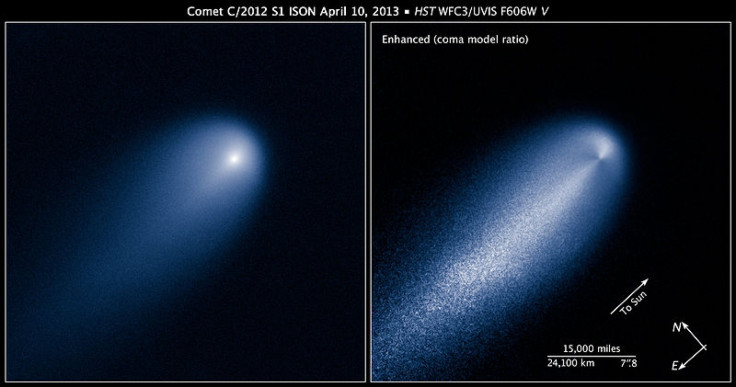Comet ISON Approaching Mars: How To See It Through A Telescope

A starry messenger is looming on the horizon. While it’s not yet bright enough to be seen with the naked eye, Comet ISON is rushing closer to Earth with every passing day, and if you break out the telescope, you might be able to catch a glimpse of it.
ISON is a sun-grazing comet, meaning that it will pass very close to our sun on its orbit. Come November, ISON could be bright enough to see in broad daylight. But for now, observers are pegging its brightness at an apparent magnitude of about 13, which is still too faint to be seen by the naked eye (which, under good conditions, can usually only pick up things with a brightness of less than an apparent magnitude of 6). For comparison, the North Star has an apparent magnitude of 2, and the full moon has an apparent magnitude of -13.
Amateur astronomer Bob King offers tips on viewing ISON through a telescope in an article at Universe Today. In the Northern Hemisphere, the best time to see the comet is in the very early morning. For the next few days, ISON can be spotted a few degrees east of Mars and two degrees north of a cluster of stars known as the Beehive Cluster.
“I also encourage you to use averted vision, a great technique for spotting faint sky objects,” King writes. “Instead of staring directly at the comet, look off to the side of its position. That way you allow the comet’s feeble photons to flood your eye’s rod cells, those most sensitive to dim light.”
But the Curiosity rover or the Mars Reconnaissance Orbiter may get a better view of ISON long before any of us do. The comet is scheduled to come within 6.5 million miles of Mars in about a month.
"Comet ISON is paying a visit to the Red Planet," astronomer Carey Lisse of the Johns Hopkins University Applied Physics Lab said in a statement. "On Oct. 1, the comet will pass within 0.07 AU [astronomical unit, equal to the distance between the Earth and the sun, or about 93 million miles] from Mars, about six times closer than it will ever come to Earth."
The MRO circling Mars could possibly snap a photo of ISON using its half-meter-long telescope, HiRISE. Though HiRISE is meant more for taking shots of Mars than for astronomy observations, its operators still plan to make observations of the comet as it swings by.
At the same time ISON passes by Mars, it will have crossed the “frost line,” where heat from the sun is just hot enough to turn water ice to vapor. Once ISON crosses the frost line, scientists expect to see massive geysers of gas stream off of the comet’s surface. The geysers should also give researchers an idea of how big ISON’s central nucleus is. And they expect that if the nucleus is bigger than about half a kilometer, then it will survive after its close brush with the sun around Thanksgiving Day. If it is smaller, the sun may tear the comet apart – all the more reason to get a viewing in while you still can!
© Copyright IBTimes 2024. All rights reserved.





















